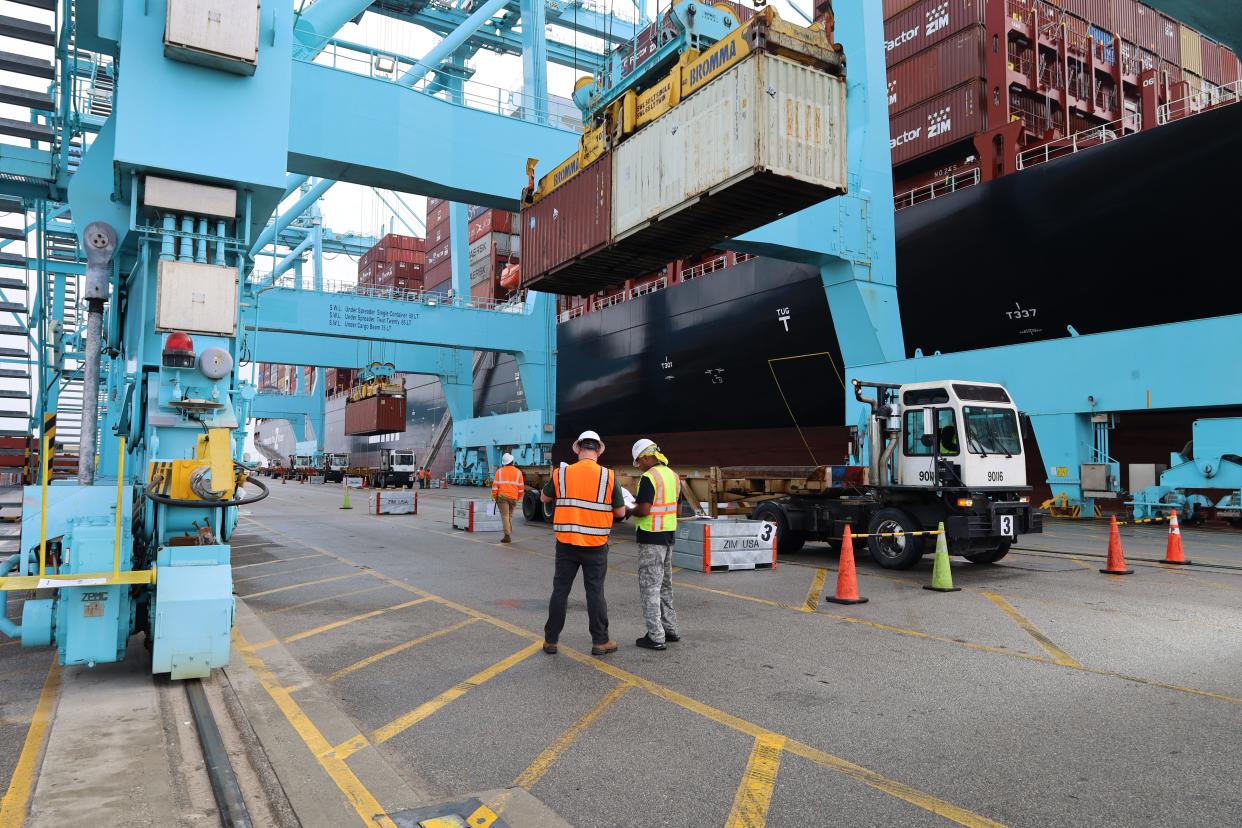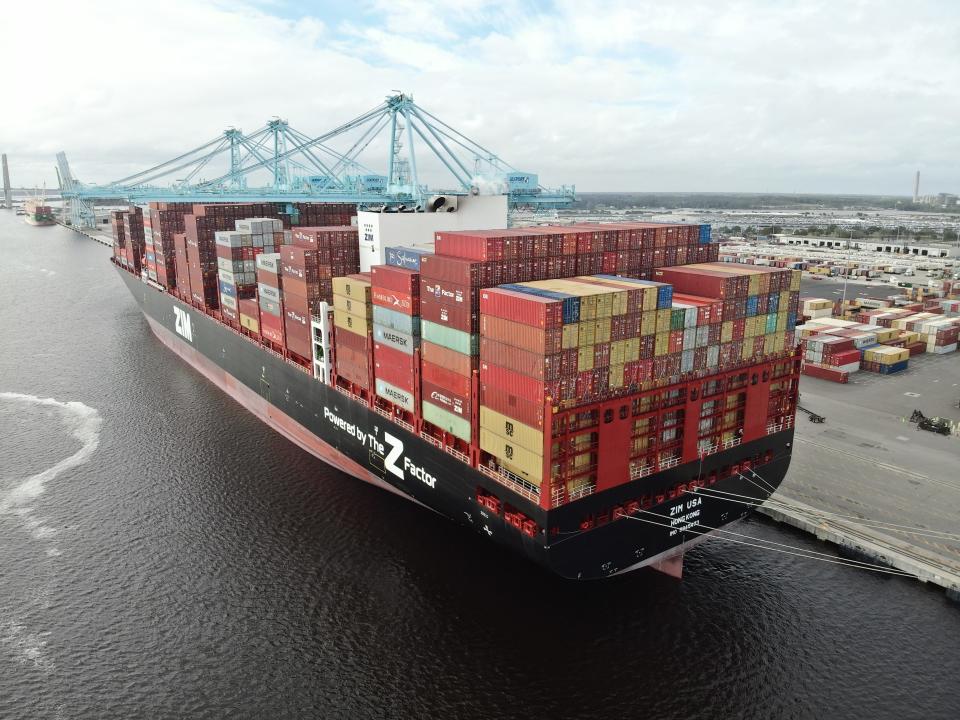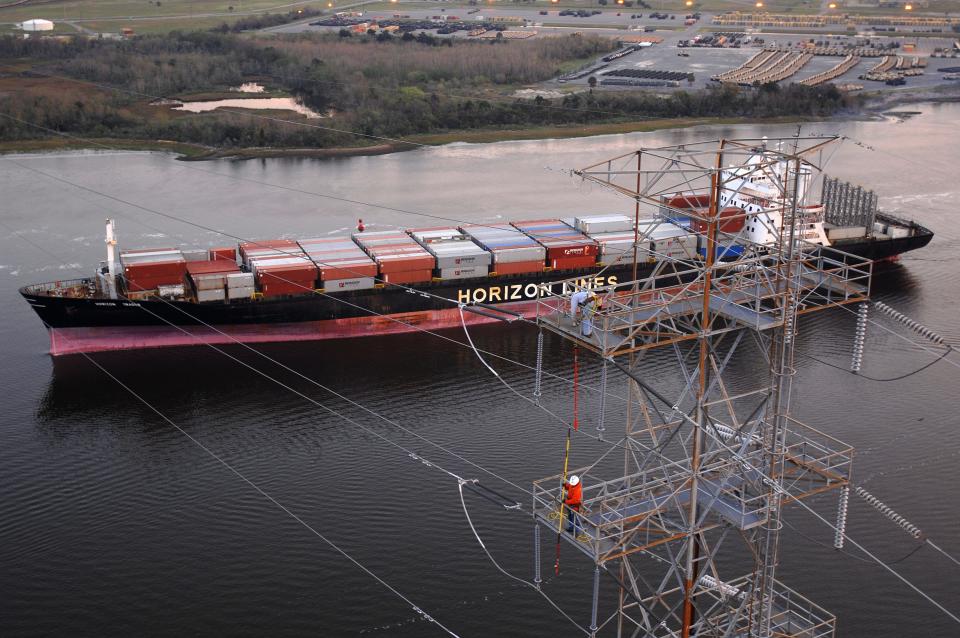Jacksonville approves $10 million to raise power lines as JaxPort tries to regain Asian cargo

Jacksonville's port is set to get another round of money from the city of Jacksonville and state of Florida for attracting jumbo-sized cargo container ships.
But behind the scenes of huge ships sailing up the river, JaxPort is trying to rebound from a drop in Asian cargo coming through Jacksonville since hitting a high-water mark three years ago.
The next improvement slated for the port will be to raise the transmission lines that span the St. Johns River, coming after the U.S. Army Corps of Engineers completed dredging the St. Johns River to serve those big ocean-crossing ships.
Jacksonville City Council unanimously agreed this week to chip in $10 million of the projected $45 million financing for elevating the power lines, joining JaxPort and the state Department of Transportation in making commitments for the work.
Ever since JaxPort entered the costly competition to win a share of Asian cargo coming to the East Coast, it has pointed to the jobs those containers generate for longshoremen, truck drivers, distribution center workers and others involved regionally in moving those containers between land and sea.
More:Jacksonville's port joins Savannah and Miami in deep-water club for Asian cargo
Raising lines:JaxPort seeks $10 million from city for raising JEA power lines across St. Johns River
Tenant shuffle:TraPac will exit Jacksonville's port and be replaced by Ceres Terminals at 158-acre site
JaxPort CEO Eric Green said the port authority talks daily with major shipping lines about bringing more cargo through Jacksonville. He said it's a methodical process of building up that business over time.
"If you don't make the improvements and the investments, you're not in the game," Green said. "It's that simple."
He said the investments also enable JaxPort to keep international cargo and the related jobs that would otherwise go to other ports.
"I think the best way to look at the investments that JaxPort is making is if you don't make those investments, one thing for sure is the international cargo that you have will go elsewhere, simply because you're not making the investments as they transition into having bigger ships," he said.
JaxPort's best year for Asian trade came in 2019
After the TraPac terminal catering to Asian trade opened in 2009, JaxPort's Asian-related cargo business grew year by year to the equivalent of 441,184 20-foot cargo containers a decade later. After that peak in the 2019 fiscal year, the growth trend reversed itself. In the 2022 fiscal year that ended Sept. 30, JaxPort had 239,420 cargo containers from its Asian trade.
Jacksonville remains a hub for shipments between the United States and Puerto Rico, and also has connections with the Caribbean and South America.
The ships on those trade lanes do not need the deeper water that larger ships crossing the ocean do. While Asian-based cargo was falling, cargo from other trade lanes kept Jacksonville in growth mode with a record-setting high mark of about 1.4 million containers in the 2021 fiscal year.
But in the recently completed 2022 fiscal year, the total number dropped to just under 1.3 million cargo containers. JaxPort expects the number will rebound to roughly 1.4 million containers in the current fiscal year that goes through the end of September.
In a major change during the past year, TraPac Jacksonville, which was wholly owned by Mitsui O.S.K. Lines, pulled out of Jacksonville and its 158-acre terminal was taken over by Ceres Terminals. The main hub for Asian trade has shifted to Blount Island where SSA Marine operates.
JaxPort said last month that ZIM Integrated Shipping Services, which calls on SSA Marine, upsized its ships going to Jacksonville by using two larger 11,700-TEU ships and two larger 11,923-TEU vessels that call on ports in China, South Korea and Jamaica.

JaxPort said they are the biggest ships to be in a regular rotation at a JaxPort terminal, a development made possible by the river deepening.
“We are thrilled that the recent investment in the harbor deepening project has so quickly created opportunities for larger vessels to serve the port, Florida, and the nation," state Department of Transportation Secretary Jared W. Perdue said when JaxPort made the announcement.
The height of the JEA transmission lines near the Blount Island terminal don't prevent those ships from reaching Blount Island, but even larger cargo container ships are calling on East Coast ports.
Elleman City Liners, based in the London area, started services between Jacksonville and Europe in late December by using SSA at Blount Island, giving Jacksonville a regular port connection to Europe cargo for the first time in years.
SeaLead Shipping started service in 2021 at Blount Island for shipments between Jacksonville and ports in China and South Korea.

East Coast ports have seen a shift of cargo from West Coast ports in recent years, but Jacksonville has had to fight the gravitational pull of Savannah, Ga., to get a share of that cargo. Savannah, which is one of the busiest ports in the nation, handled the equivalent of 5.76 million 20-foot cargo containers in the 2022 fiscal year, an increase of about 8%.
Green said the nature of the cargo business is that Jacksonville's growth will come from gains that aren't large by themselves, but add up when taken together.
"We're going to continue to do what we think we do best and that is to to beat the drums and go after this cargo," he said.
This article originally appeared on Florida Times-Union: JaxPort sees drop in Asian trade but gets more city and FDOT money

